The Characteristics and Possible Mechanisms of the Strongest Ionospheric Irregularities in March 2024
Abstract
1. Introduction
2. Data and Methods
3. Results
3.1. IMF and Geomagnetic Conditions
3.2. Results from BDS-GEO TFT
3.3. Results from ROTI
3.4. GNSS Scintillation
3.5. Spread F from Ionograms
3.6. In Situ Measurements
4. Discussion
4.1. The Spatial Range and Scale of the EPBs
4.2. The Evolution of the EPBs
4.3. The Possible Physical Mechanism of the EPBs
5. Conclusions
Author Contributions
Funding
Institutional Review Board Statement
Informed Consent Statement
Data Availability Statement
Acknowledgments
Conflicts of Interest
References
- Booker, H.G.; Wells, H.W. Scattering of radio waves by the F-region of the ionosphere. Terr. Magn. Atmos. Elec. 1938, 43, 249–256. [Google Scholar] [CrossRef]
- Booker, H.G. Turbulence in the ionosphere with applications to meteortrails, radio-star scintillation, auroral radar echoes, and other phenomena. J. Geophys. Res. 1956, 61, 673–705. [Google Scholar] [CrossRef]
- Woodman, R.F.; La Hoz, C. Radar observations of F region equatorial irregularities. J. Geophys. Res. 1976, 81, 5447–5466. [Google Scholar] [CrossRef]
- Hanson, W.B.; Bamgboye, D.K. The measured motions inside equatorial plasma bubbles. J. Geophys. Res. 1984, 89, 8997. [Google Scholar] [CrossRef]
- Hysell, D.L. An overview and synthesis of plasma irregularities in equatorial spread F. J. Atmos. Sol.-Terr. Phys. 2000, 62, 1037–1056. [Google Scholar] [CrossRef]
- Meggs, R.W.; Mitchell, C.N.; Smith, A.M. An Investigation into the Relationship between Ionospheric Scintillation and Loss of Lock in GNSS Receivers. In Characterising the Ionosphere; Meeting Proceedings RTO-MP-IST-056, Paper 5; RTO: Neuilly-sur-Seine, France, 2006; pp. 5-1–5-10. Available online: http://www.rto.nato.int/abstracts.asp (accessed on 6 November 2009).
- Zhang, D.; Cai, L.; Hao, Y.; Xiao, Z.; Shi, L.; Yang, G.; Suo, Y. Solar cycle variation of the GPS cycle slip occurrence in China low-latitude region. Space Weather 2010, 8, S10D10. [Google Scholar] [CrossRef]
- Zhang, D.; Xiao, Z.; Feng, M.; Hao, Y.; Shi, L.; Yang, G.; Suo, Y. Temporal dependence of GPS cycle slip related to ionospheric irregularities over China low-latitude region. Space Weather 2010, 8, S04D08. [Google Scholar] [CrossRef]
- Abdu, M.A. Day-to-day and short-term variabilities in the equatorial plasma bubble/spread F irregularity seeding and development. Prog. Earth Planet Sci. 2019, 6, 11. [Google Scholar] [CrossRef]
- Tsunoda, R.T. Satellite traces: An ionogram signature for large-scale wave structure and a precursor for equatorial spread F. Geophys. Res. Lett. 2008, 35, L20110. [Google Scholar] [CrossRef]
- Nishioka, M.; Saito, A.; Tsugawa, T. Occurrence characteristics of plasma bubble derived from global ground-based GPS receiver networks. J. Geophys. Res. 2008, 113, A05301. [Google Scholar] [CrossRef]
- Li, G.; Ning, B.; Otsuka, Y.; Abdu, M.; Abadi, P.; Liu, Z.; Spogli, L.; Wan, W. Challenges to equatorial plasma bubble and ionospheric scintillation short- term forecasting and future aspects in East and Southeast Asia. Surv. Geophys. 2021, 42, 201–238. [Google Scholar] [CrossRef]
- Shi, J.; Wang, G.; Reinisch, B.; Shang, S.; Wang, X.; Zherebotsov, G.; Potekhin, A. Relationship between strong range spread F and ionospheric scintillations observed in Hainan from 2003 to 2007. J. Geophys. Res. 2011, 116, A08306. [Google Scholar] [CrossRef]
- Aarons, J. The role of the ring current in the generation or inhibition of equatorial F layer irregularities during magnetic storms. Radio Sci. 1991, 26, 1131–1149. [Google Scholar] [CrossRef]
- Ma, G.; Maruyama, T. A super bubble detected by dense GPS network at East Asian longitudes. Geophys. Res. Lett. 2006, 33, L21103. [Google Scholar] [CrossRef]
- Sun, W.; Li, G.; Lei, J.; Zhao, B.; Hu, L.; Zhao, X.; Li, Y.; Xie, H.; Li, Y.; Ning, B.; et al. Ionospheric super bubbles near sunset and sunrise during the 26–28 February 2023 geomagnetic storm. J. Geophys. Res. Space Phys. 2023, 128, e2023JA031864. [Google Scholar] [CrossRef]
- Li, G.; Ning, B.; Hu, L.; Liu, L.; Yue, X.; Wan, W.; Zhao, B.; Igarashi, K.; Kubota, M.; Otsuka, Y.; et al. Longitudinal development of low-latitude ionospheric irregularities during the geomagnetic storms of July 2004. J. Geophys. Res. 2010, 115, A04304. [Google Scholar] [CrossRef]
- Carter, B.A.; Yizengaw, E.; Pradipta, R.; Retterer, J.M.; Groves, K.; Valladares, C.; Caton, R.; Bridgwood, C.; Norman, R.; Zhang, K. Global equatorial plasma bubble occurrence during the 2015 St. Patrick’s Day storm. J. Geophys. Res. Space Phys. 2016, 121, 894–905. [Google Scholar] [CrossRef]
- Nayak, C.; Tsai, L.C.; Su, S.Y.; Galkin, I.A.; Caton, R.G.; Groves, K.M. Suppression of ionospheric scintillation during St. Patrick’s Day geomagnetic super storm as observed over the anomaly crest region station Pingtung, Taiwan: A case study. Adv. Space Res. 2017, 60, 396–405. [Google Scholar] [CrossRef]
- Kelley, M.C.; Fejer, B.; Gonzales, C. An explanation for anomalous equatorial ionospheric electric fields associated with a northward turning of the interplanetary magnetic field. Geophys. Res. Lett. 1979, 6, 301–304. [Google Scholar] [CrossRef]
- Blanc, M.; Richmond, A. The ionospheric disturbance dynamo. J. Geophys. Res. 1980, 85, 1669–1686. [Google Scholar] [CrossRef]
- Balan, N.; Liu, L.; Le, H. Brief review of equatorial ionization anomaly and ionospheric irregularities. Earth Planet Phys. 2018, 2, 1–19. [Google Scholar] [CrossRef]
- Wu, K.; Qian, L.; Wang, W.; Cai, X.; Mclnerney, J.M. Investigation of the physical mechanisms of the formation and evolution of equatorial plasma bubbles during a moderate storm on 17 September 2021. Space Weather 2023, 21, e2023SW003673. [Google Scholar] [CrossRef]
- Lin, Z.W.; Chao, C.K.; Liu, J.Y.; Huang, C.M.; Chu, Y.H.; Su, C.L.; Mao, Y.C.; Chang, Y.S. Advanced Ionospheric Probe scientific mission onboard FORMOSAT-5 satellite. Terr. Atmos. Ocean. Sci. 2017, 28, 99–110. [Google Scholar] [CrossRef]
- Friis-Christensen, E.; Lühr, H.; Knudsen, D.; Haagmans, R. Swarm-an Earth observation mission investigating geospace. Adv. Space Res. 2008, 41, 210–216. [Google Scholar] [CrossRef]
- Pi, X.; Mannucci, A.J.; Lindqwister, U.J.; Ho, C.M. Monitoring of global ionospheric irregularities using the worldwide GPS network. Geophys. Res. Lett. 1997, 24, 2283–2286. [Google Scholar] [CrossRef]
- Ma, G.; Li, J.; Fan, J.; Wan, Q.; Maruyama, T.; Dong, L.; Gao, Y.; Zhang, L.; Wang, D. Observation of Post-Sunset Equatorial Plasma Bubbles with BDS Geostationary Satellites over South China. Remote Sens. 2024, 16, 3521. [Google Scholar] [CrossRef]
- Aarons, J.; Mendillo, M.; Yantosca, R. GPS phase fluctuations in the equatorial region during the MISETA 1994 cmapaign. J. Geophys. Res. 1996, 101, 26851–26862. [Google Scholar] [CrossRef]
- Basu, S.; Basu, S.; Aarons, J.; McClure, J.P.; Cousins, M.D. On the coexistence of kilometer- and meter-scale irregularities in the nighttime equatorial F-region. J. Geophys. Res. 1978, 83, 4219–4226. [Google Scholar] [CrossRef]
- Beach, T.L. Perils of the GPS phase scintillation index (sf). Radio Sci. 2006, 41, RS5S31. [Google Scholar] [CrossRef]
- Sales, G.S.; Reinisch, B.W.; Scali, J.L.; Dozois, C.; Bullett, T.W.; Weber, E.J.; Ning, P. Spread F and the structure of equatorial ionization depletions in the southern anomaly region. J. Geophys. Res. 1996, 101, 26819–26827. [Google Scholar] [CrossRef]
- Yokoyama, T.; Shinagawa, H.; Jin, H. Nonlinear growth, bifurcation, and pinching of equatorial plasma bubble simulated by three-dimensional high-resolution bubble model. J. Geophys. Res. Space Phys. 2014, 119, 10474–10482. [Google Scholar] [CrossRef]
- Patil, A.S.; Nade, D.P.; Taori, A.; Pawar, R.R.; Pawar, S.M.; Nikte, S.S.; Pawar, S.D. A Brief Review of Equatorial Plasma Bubbles. Space Sci. Rev. 2023, 219, 16. [Google Scholar] [CrossRef]
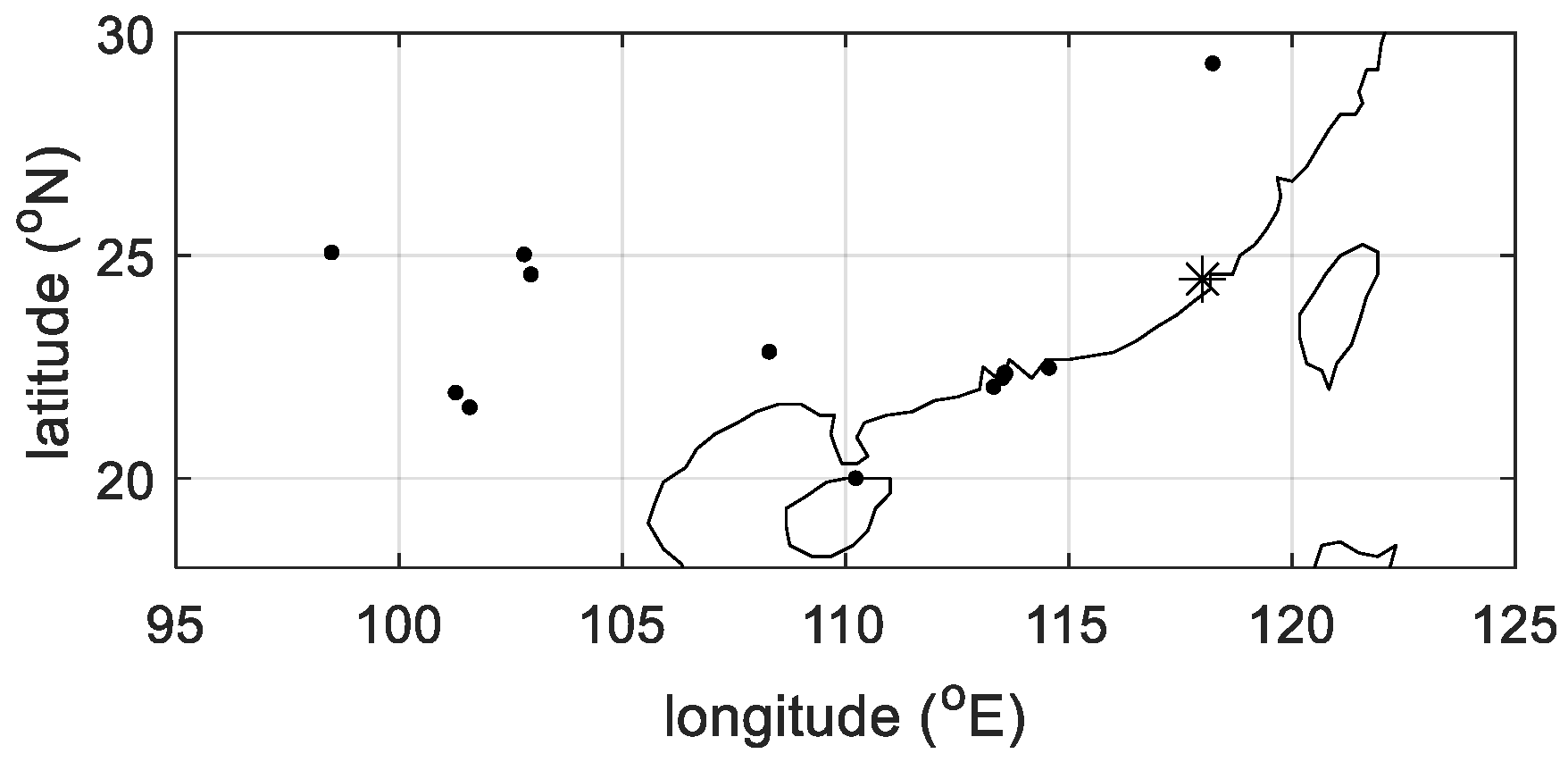
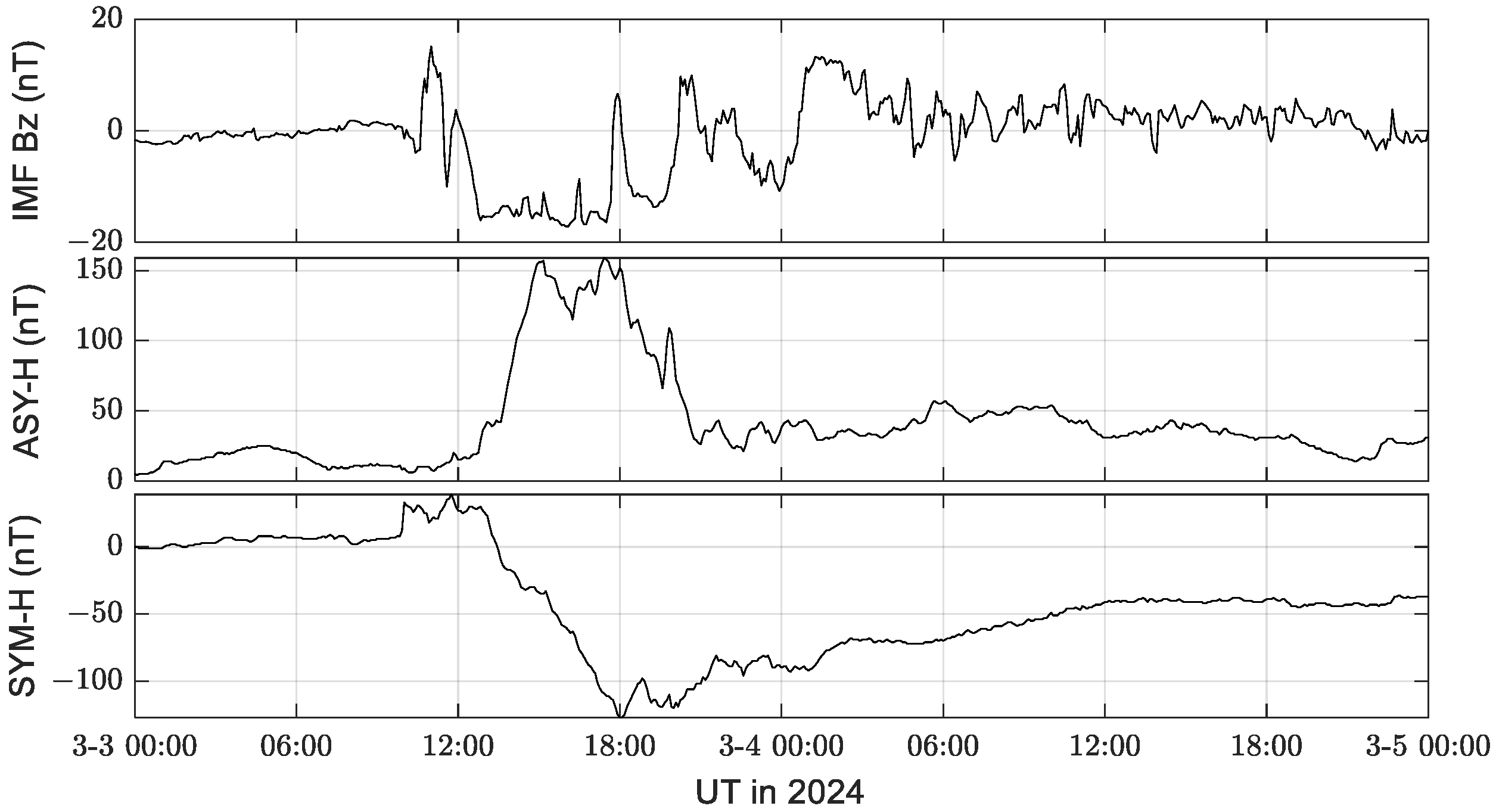
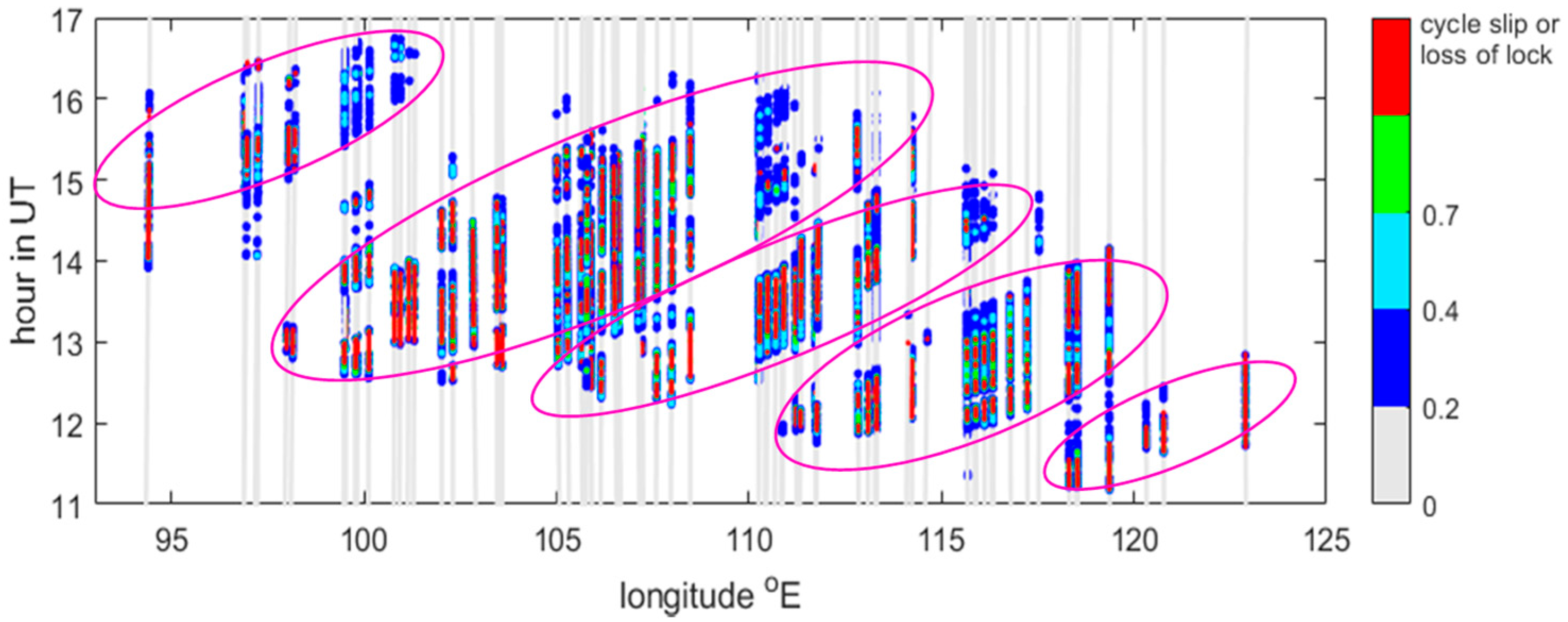
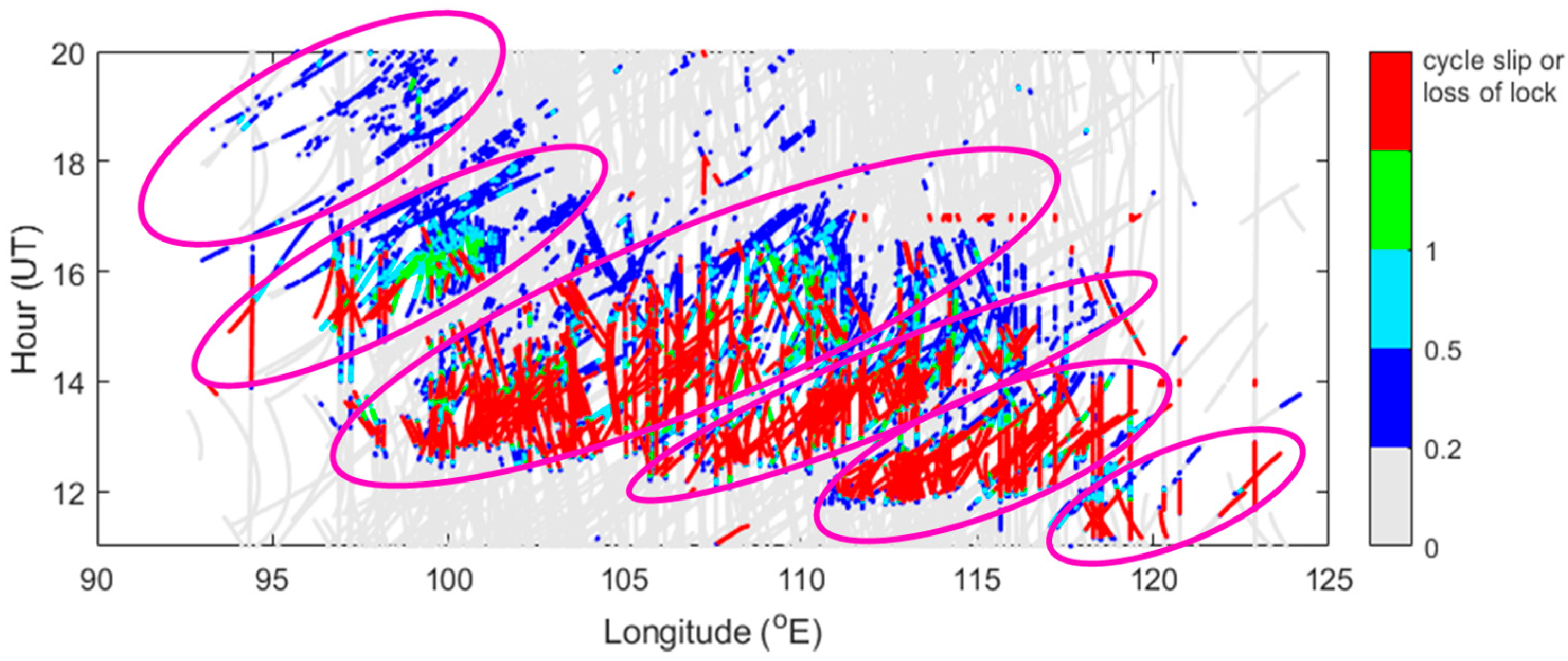
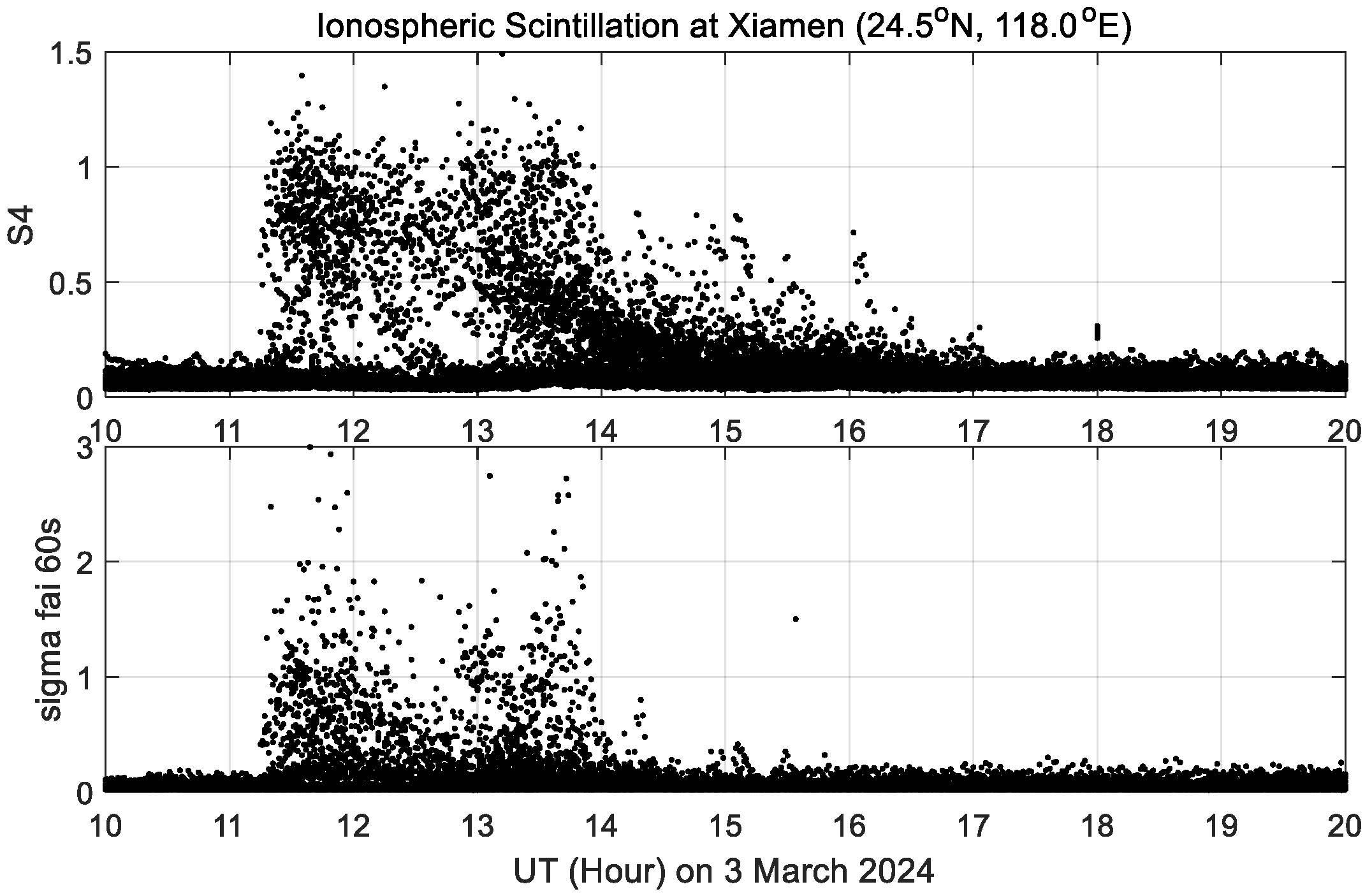
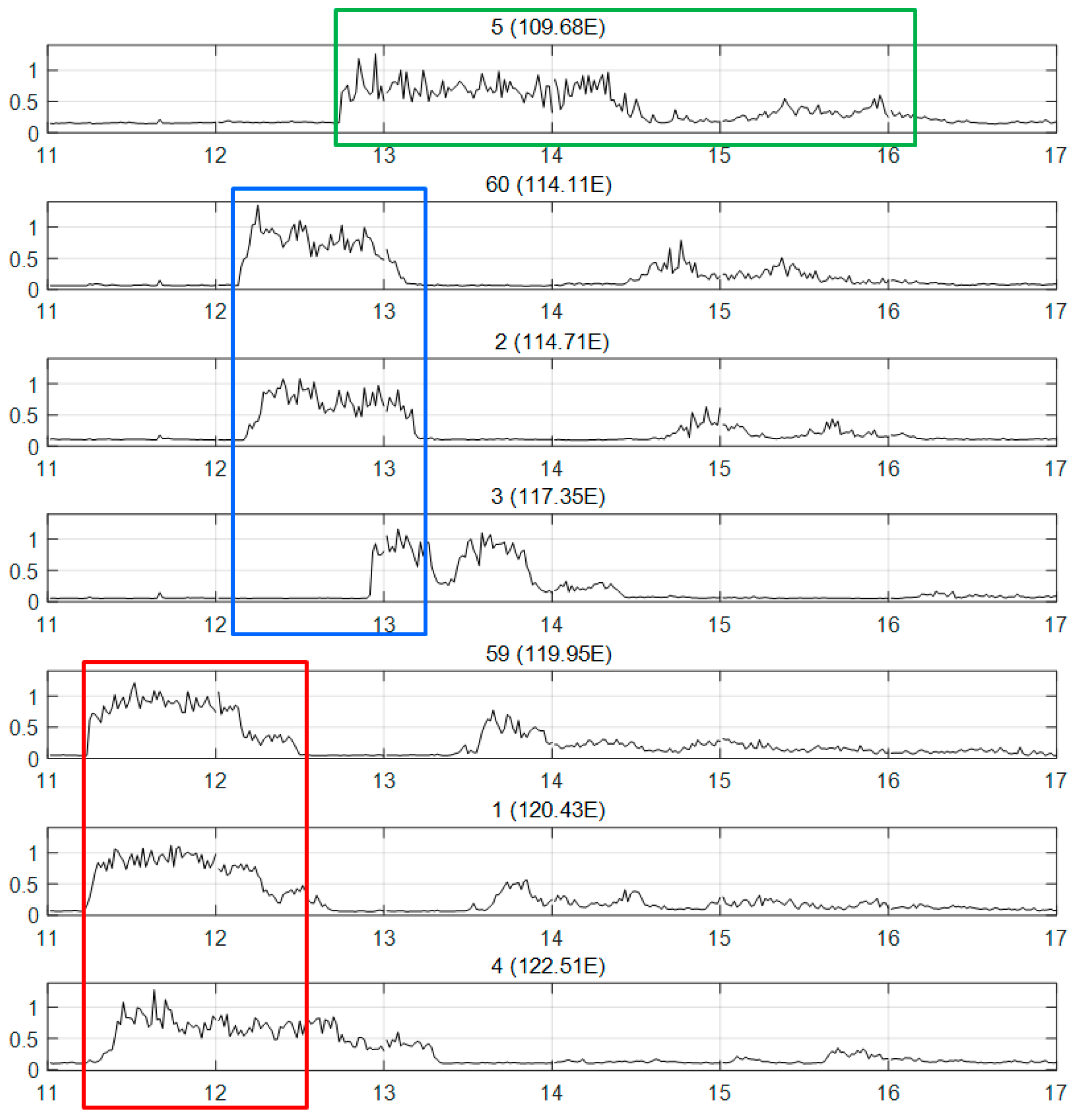
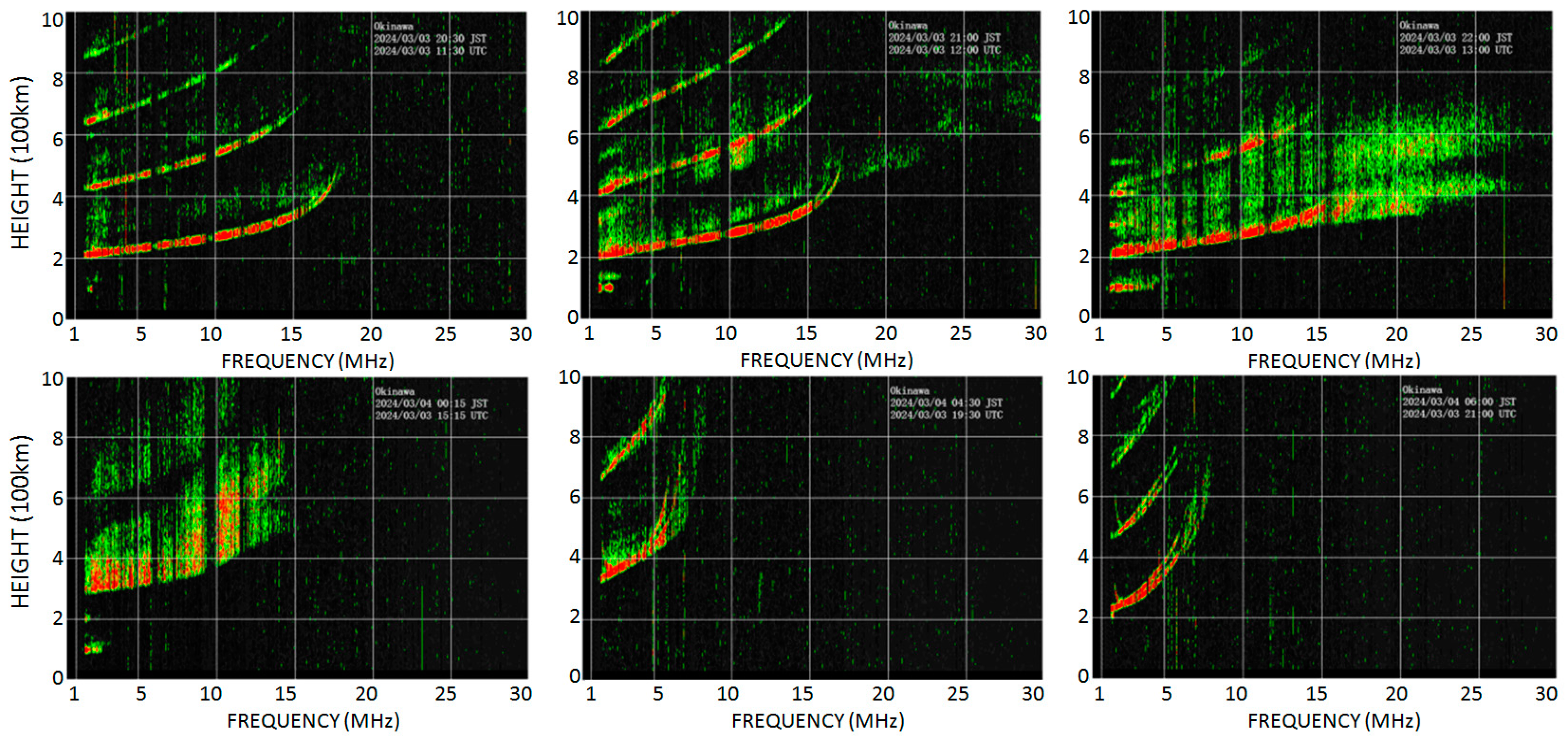


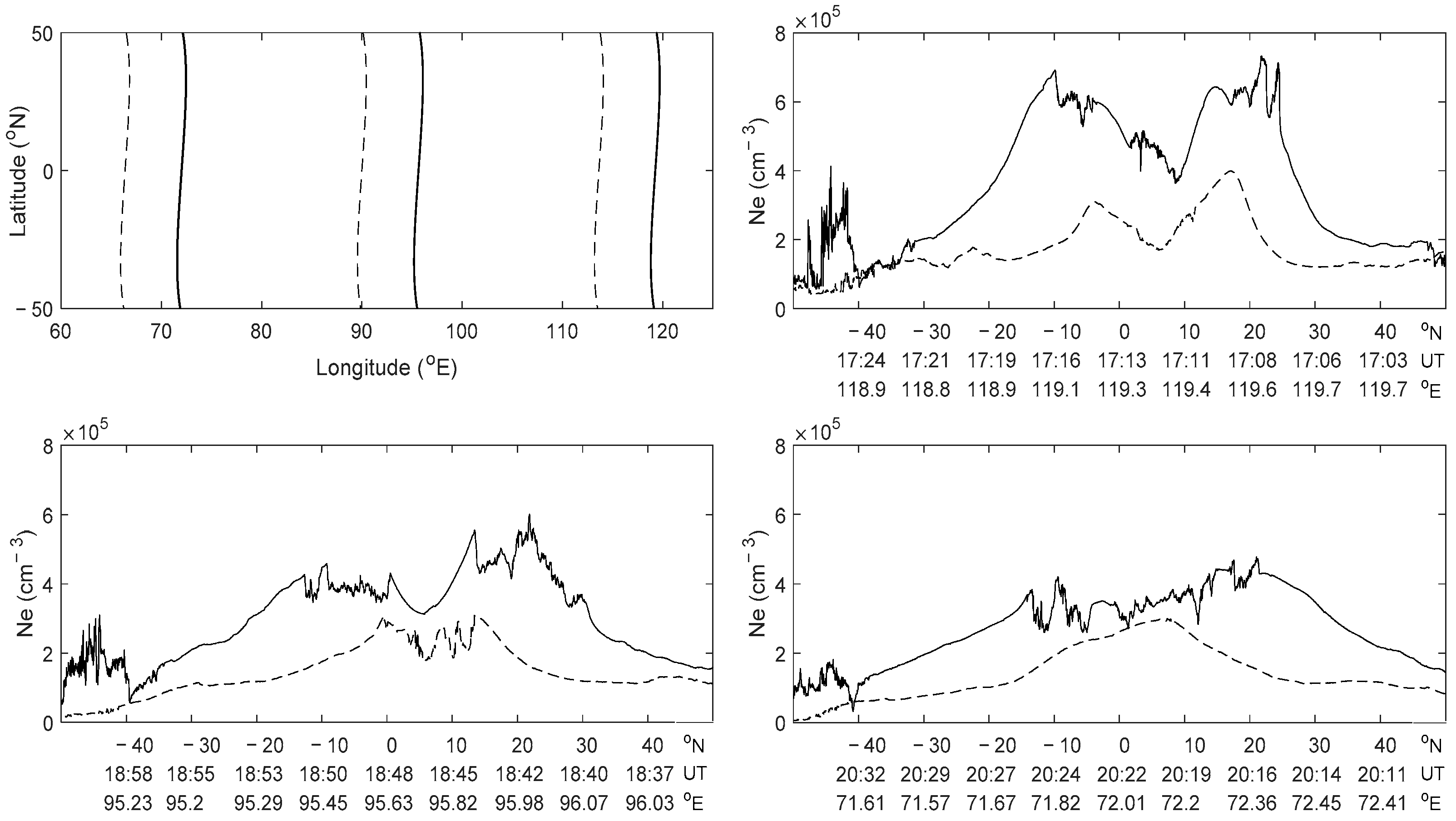
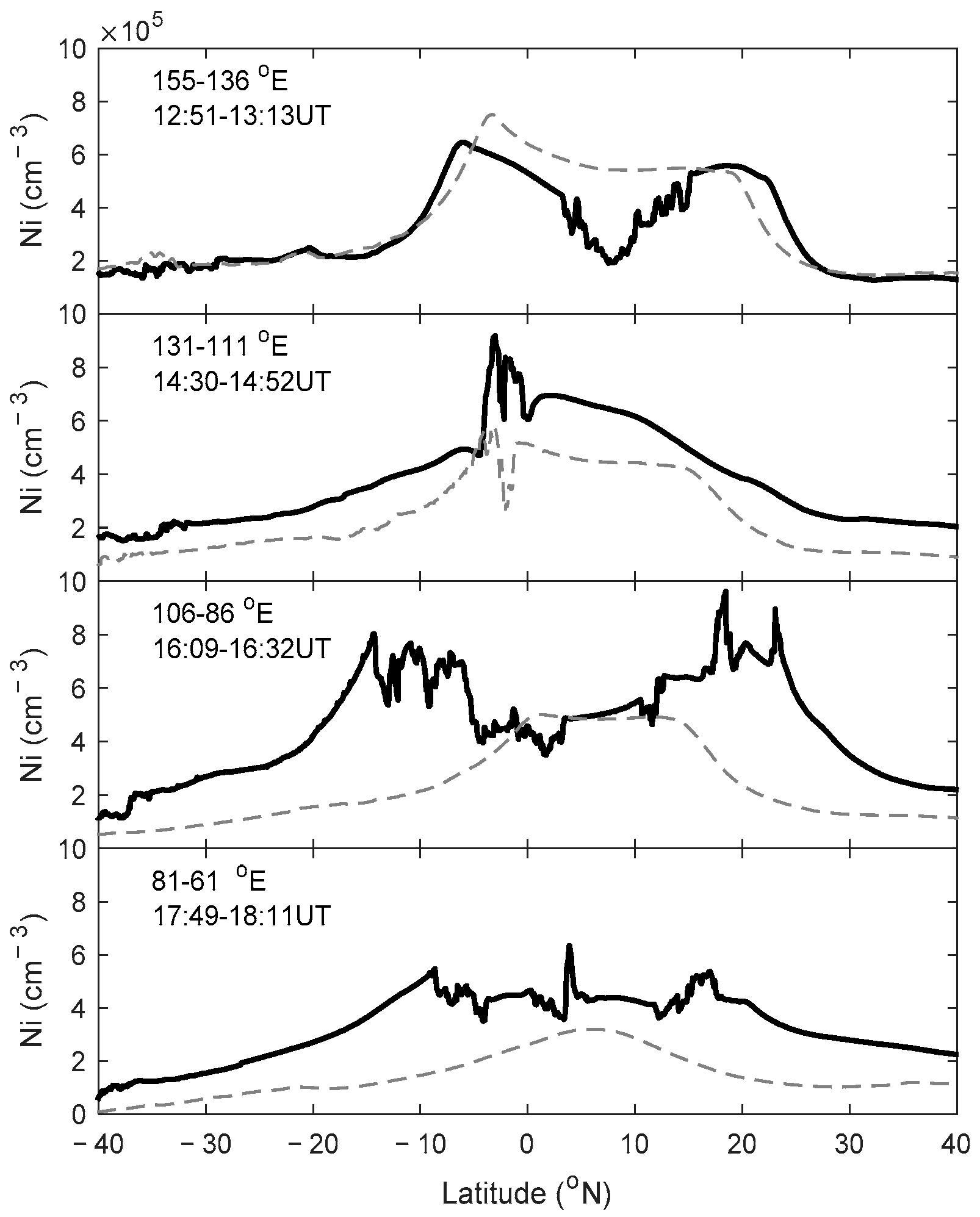
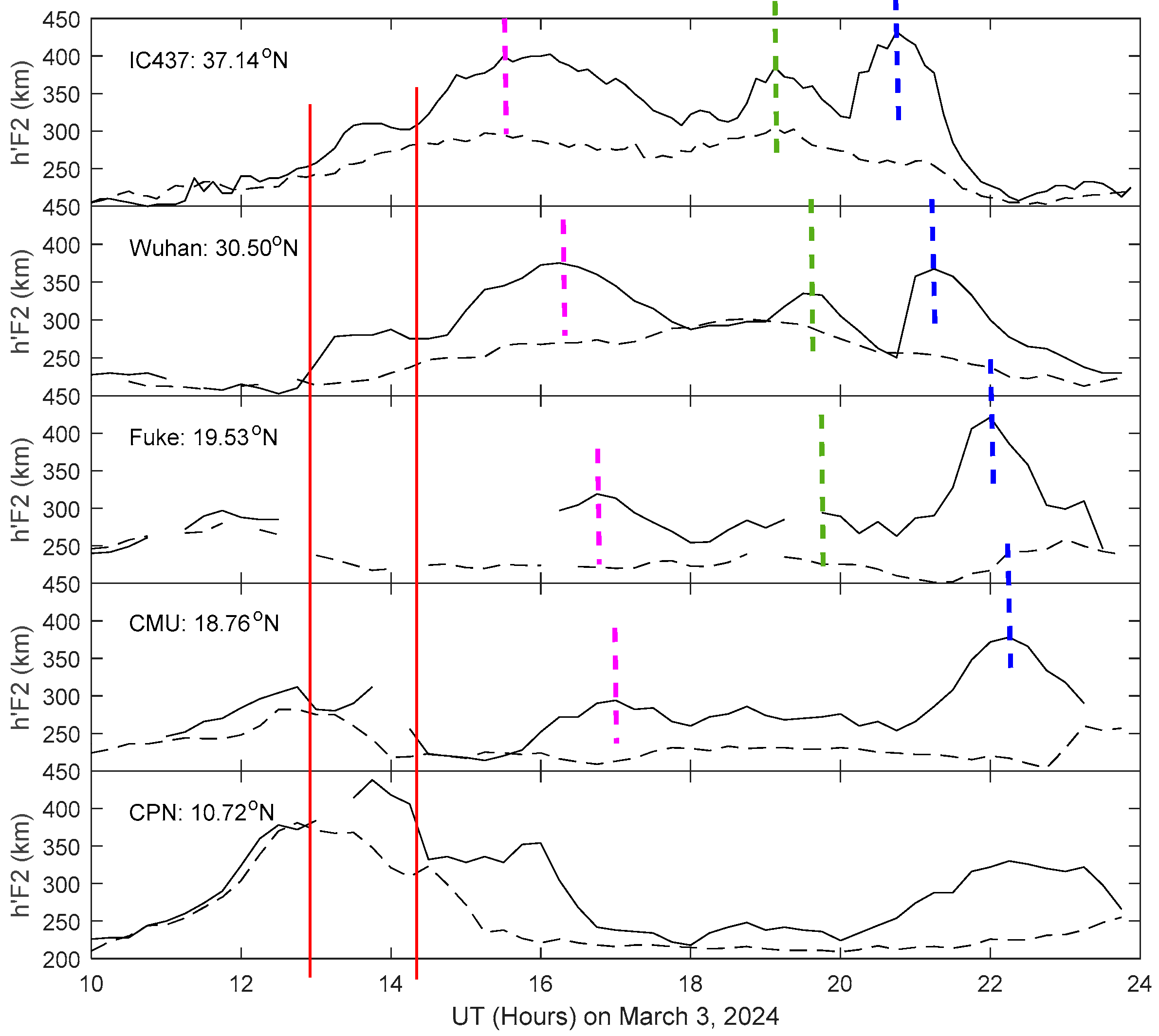
| Station ID | Geographic Latitude (°N) | Geographic Longitude (°E) | Geomagnetic Latitude (°N) | Organization |
|---|---|---|---|---|
| IC437 | 37.14 | 127.54 | 31.49 | GIRO |
| Wuhan | 30.50 | 114.48 | 22.45 | Meridian Project |
| OKI | 26.68 | 128.15 | 18.55 | NICT |
| Fuke | 19.53 | 109.13 | 14.08 | Meridian Project |
| CMU | 18.76 | 98.93 | 9.33 | SEALION |
| CPN | 10.72 | 99.37 | 1.33 | SEALION |
| Station ID | Geographic Latitude | Duration of Spread F (UT) | Data Gap (UT) |
|---|---|---|---|
| OKI | 26.68° N | 11:30–21:00 | --- |
| Fuke | 19.53° N | 12:15 3 March–02:15 4 March | 14:15–16:15; 18:30–18:45 20:30–22:00; 02:30–03:30 |
Disclaimer/Publisher’s Note: The statements, opinions and data contained in all publications are solely those of the individual author(s) and contributor(s) and not of MDPI and/or the editor(s). MDPI and/or the editor(s) disclaim responsibility for any injury to people or property resulting from any ideas, methods, instructions or products referred to in the content. |
© 2025 by the authors. Licensee MDPI, Basel, Switzerland. This article is an open access article distributed under the terms and conditions of the Creative Commons Attribution (CC BY) license (https://creativecommons.org/licenses/by/4.0/).
Share and Cite
Li, J.; Ma, G.; Fan, J.; Wan, Q.; Maruyama, T.; Zhang, J.; Chao, C.-K.; Dong, L.; Wang, D.; Gao, Y.; et al. The Characteristics and Possible Mechanisms of the Strongest Ionospheric Irregularities in March 2024. Atmosphere 2025, 16, 218. https://doi.org/10.3390/atmos16020218
Li J, Ma G, Fan J, Wan Q, Maruyama T, Zhang J, Chao C-K, Dong L, Wang D, Gao Y, et al. The Characteristics and Possible Mechanisms of the Strongest Ionospheric Irregularities in March 2024. Atmosphere. 2025; 16(2):218. https://doi.org/10.3390/atmos16020218
Chicago/Turabian StyleLi, Jinghua, Guanyi Ma, Jiangtao Fan, Qingtao Wan, Takashi Maruyama, Jie Zhang, Chi-Kuang Chao, Liang Dong, Dong Wang, Yang Gao, and et al. 2025. "The Characteristics and Possible Mechanisms of the Strongest Ionospheric Irregularities in March 2024" Atmosphere 16, no. 2: 218. https://doi.org/10.3390/atmos16020218
APA StyleLi, J., Ma, G., Fan, J., Wan, Q., Maruyama, T., Zhang, J., Chao, C.-K., Dong, L., Wang, D., Gao, Y., & Zhang, L. (2025). The Characteristics and Possible Mechanisms of the Strongest Ionospheric Irregularities in March 2024. Atmosphere, 16(2), 218. https://doi.org/10.3390/atmos16020218






